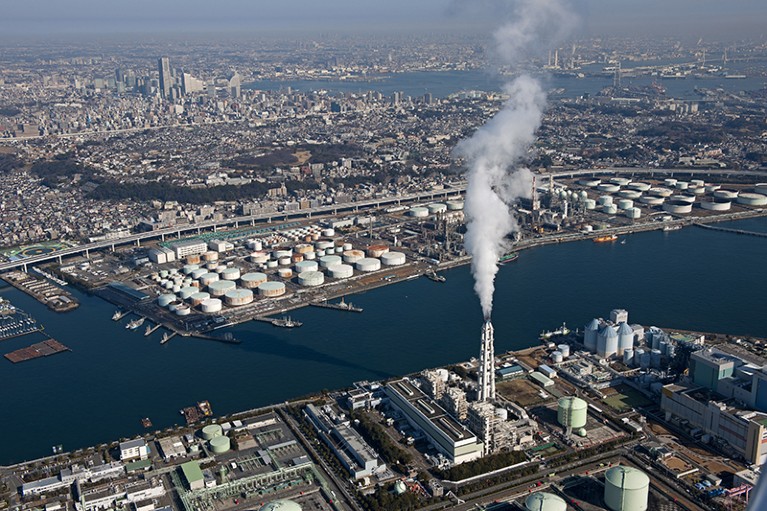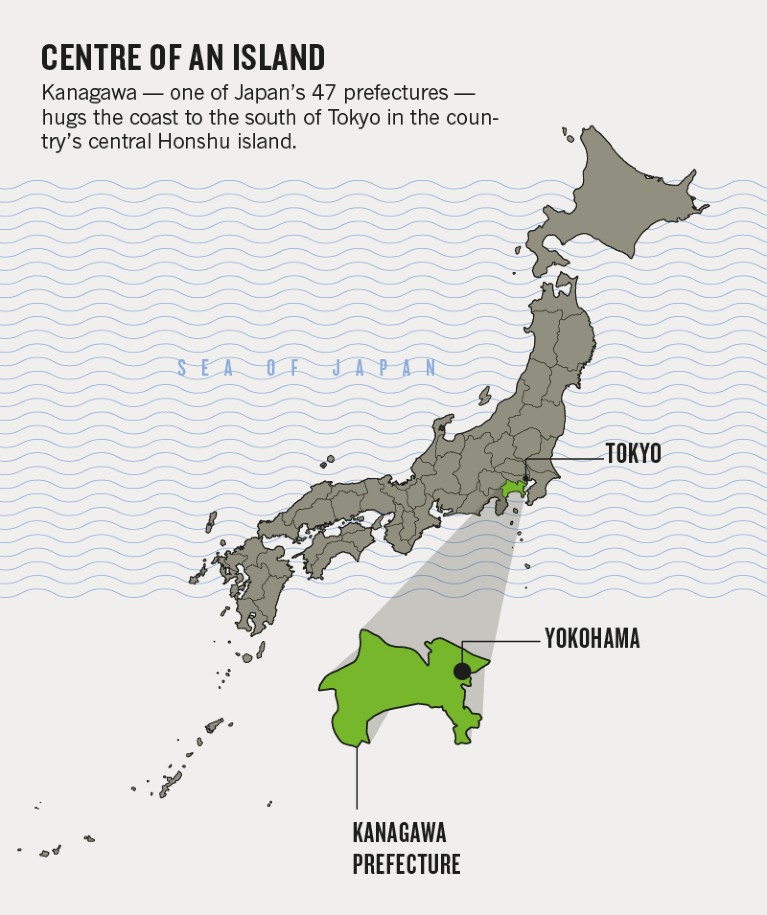
Kanagawa hosts a concentration of heavy industry.Credit: JTB Photo/UIG via Getty
Given its ready access to the economic juggernaut of Tokyo, it would be easy to imagine next-door Kanagawa and its metropolitan area of Yokohama–Kawasaki to be little more than a satellite ‘bed town’. But the region is very much a destination in its own right — a rich ecosystem built on a pairing of the industry and research and development (R&D) for which Japan is renowned.
Kanagawa is the second most populous of Japan’s 47 prefectures, and home to the nation’s second largest city, Yokohama. The region stretches along the coast of the country, from the south of Tokyo to the foot of Mount Fuji (see ‘Centre of an island’). The bayside area forms what is known as the Keihin region — Japan’s largest concentration of heavy-industry and manufacturing organizations. The region was the industrial powerhouse of Japan’s rapid recovery after the Second World War, but it has now evolved a new character, driven by the promotion of an innovative R&D culture and attractive incentives for international investment.
“Kanagawa has the largest pool of researchers in Japan,” says Tōru Hashimoto, executive director of development cooperation for Yokohama City Government. “We have so many research labs and institutes, and a real environment of innovation.” Hashimoto points to the technology giant Apple as a beneficiary of that environment. In 2016, the world’s most valuable company established one of its first R&D centres outside the United States in the prefecture. “I think this shows how attractive this area has become for global R&D,” Hasimoto says.

Kanagawa claims more than 60,000 research staff, a full 50% more than in Tokyo. They work in more than 1,000 research facilities, and many are in the prefecture’s 40 universities. They include some of Japan’s foremost institutes: the RIKEN Yokohama Campus, the Yokohama Institute for Earth Sciences, the New Energy and Industrial Technology Development Organization, the Tokyo Institute of Technology and Keio University.
Innovation by design
Kanagawa receives the obvious rewards that come from hosting so many research institutions. It is part of the Yokohama–Tokyo region, the world’s most prolific innovation centre. More than 94,000 patents were filed from the region in 2011–15, double the number from runner-up Shenzhen–Hong Kong and three times more than from third-placed Silicon Valley.
This culture is fed by the leading industrial firms that call the region home — including engineering giants Nissan and Bosch, computer manufacturers Fujitsu and Toshiba and chemical companies Shiseido and Takeda Pharmaceutical. These and hundreds of other engineering and technology firms are spurring a new culture for research labs and creating a healthy environment of collaboration between research and engineering. “In recent years, we have made a deliberate and very careful conversion from a manufacturing-dependent economy to one that is very much focused on research and innovation,” says Hashimoto. “This has resulted in a remarkable change in the composition of our workforce to be more research-oriented, and we see that trend continuing.”
A historic melting pot
Kanagawa was once the ultimate seat of power in Japan. For almost four centuries, the southern city of Kamakura was a major seat of power in Shōgun-era Japan, and it is thought to have been the fourth largest city in the world during the thirteenth century, after Hangzhou, Cairo and Fez. When Kamakura was destroyed by the Tokugawa Shogunate, the nation’s capital was relocated to what is now Tokyo. The resulting 200 years of isolationist policy in Kamakura was eventually brought to an abrupt end in 1858 when the United States and Japan — in the shadow of American gunboats — negotiated the opening of Yokohama and other Kanagawa ports for international trade. Yokohama quickly became a portal for everything Western, a true melting pot where foreign ideas, influences and technology were blended with Japanese sense and tradition before being scattered across the country.
“Through that period, the port of Yokohama was very important,” says Hashimoto. “It was the first place in Japan to get street lighting, water treatment, a lighthouse, iron bridges, street design and even railways — all Western technologies that were introduced to Japan through Yokohama.”
By the end of the nineteenth century, Yokohama was a vibrant city with a population of half a million, and bursting with technological innovations, entrepreneurship and foreigners. Yet this would all be brought to an abrupt end with the Great Kanto Earthquake of 1923, which levelled almost every building in the area. Rebuilding began in earnest, only for the city to be ruined again by air raids in the Second World War. Yet it was from these embers that Japan found the means for its economic and industrial resurgence, which was driven in no small part by the rapid restoration and rise of the Keihin Industrial Zone with its concentration of heavy industry, including steel mills, oil refineries, petrochemical complexes and shipyards.
By the 1980s, Keihin had become so successful that the Yokohama region risked being entirely consumed by heavy industry. Recognizing a need for diversification, local government decided to convert shipyards and warehouses into mixed-use business, industry, research and residential zones and create centres of employment, collaboration and innovation. Since then, successive governments have actively nurtured this environment. The most prominent of these districts, Minato Mirai 21, now forms the vibrant central business centre of Yokohama.
Clusters speed up research
A region with so many R&D institutions is bound to form research clusters with a specific scientific focus, and Kanagawa boasts many. Two of the largest are Yokosuka Research Park, with its concentration of leading wireless and mobile-communications companies, and Kanagawa Science Park, which spans a wide a range of sectors.
R&D enterprises in the region benefit from a multitude of economic incentives and support, including various incubation and innovation platforms. For example, the Keihin area has been designated a Life Innovation Comprehensive Special Zone by the national government. That brings with it a variety of incentives, including tax relief, relaxed regulations and business subsidies specifically. Further inland is the Sagami Robotics Industry Special Zone, where many of Japan’s leading and most innovative robotics companies are rapidly expanding the technology into practical applications, such as of life-support robots.
“We have had a particular focus on well-being and health care, starting roughly 20 years ago when we attracted RIKEN to establish a new life-sciences research institute in Yokohama,” says Kousuke Adachi, director of the life-innovation promotion division of the City of Yokohama. “Then, in 2003, we established the Leading Venture Plaza near the RIKEN Yokohama Campus as a low-cost incubation facility for biotech start-ups. That really laid the foundation for state-of-the-art life-sciences research and the concentration of industries in this field.”
The city also set up a life-innovation platform (LIP) in Yokohama to act as a network for cooperation between industry, academia and government in biotechnology and life sciences.
“Through the LIP, leading Japanese pharmaceutical companies and manufacturers of medical equipment, as well as leading academic institutes such as RIKEN and financial institutions, support the work of small enterprises and ventures,” says Adachi. “In all, we now have some 90 organizations participating in the LIP as a bridge between academia and the private sector to create and implement innovative projects, stimulating Yokohama’s economy and connecting the results of projects with advances in health care and well-being for our citizens.”
Kanagawa offers researchers a range of opportunities, from academic positions with organizations such as RIKEN and the Japan Agency for Marine–Earth Science and Technology (JAMSTEC), to industrial R&D with global technology giants. Finding the right position from abroad can be tricky — Japanese recruitment systems are often archaic and heavy on detailed documentation — but foreigners are generally afforded a warm welcome and respect as a source of international expertise, and most English-speaking foreign researchers can get by quite well without needing to know the local language, says Kyaw Moe, who moved to Kanagawa from Tokyo to work at the Yokohama Institute for Earth Sciences in 2001 (see ‘A researcher’s life in Kanagawa’).
That welcome does have its limits. One of the more common pathways for securing a research position in Japan is a fellowship position through the Japan Society for the Promotion of Science, but they generally last for only a couple of years and are researchers can only ever get one. Those who hope to stay longer will need to find a position with an employer who is willing to sponsor a visa application.
People fortunate enough to find a longer-term position at a university can find the strict hierarchy stifling and difficult to climb. However, the government has tried to tackle that through its Top Global University Project, which offers better employment conditions and opportunities to attract international researchers.
Kanagawa has much to offer as an alternative to Tokyo for a place to live. It is on the fringe of the limelight, yet close enough to feel part of the global circuit. Its cheaper rents and house prices and more relaxed lifestyle make Kanagawa attractive to expats and locals alike. And it may well offer researchers new opportunities in the innovation capital of Japan.








